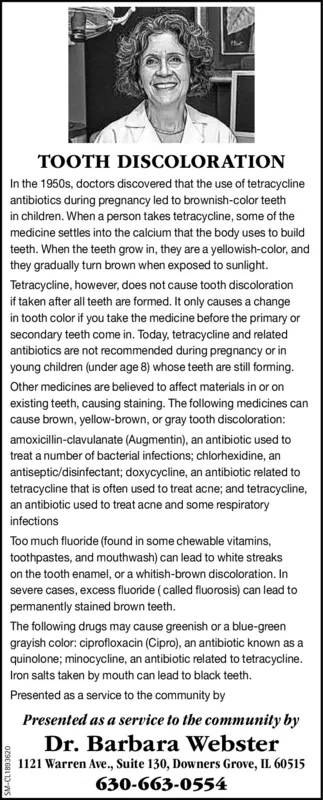Advertisement

-
Published Date
July 28, 2021This ad was originally published on this date and may contain an offer that is no longer valid. To learn more about this business and its most recent offers, click here.
Ad Text
TOOTH DISCOLORATION In the 1950s, doctors discovered that the use of tetracycline antibiotics during pregnancy led to brownish-color teeth in children. When a person takes tetracycline, some of the medicine settles into the calcium that the body uses to build teeth. When the teeth grow in, they are a yellowish-color, and they gradually turn brown when exposed to sunlight. Tetracycline, however, does not cause tooth discoloration if taken after all teeth are formed. It only causes a change in tooth color if you take the medicine before the primary or secondary teeth come in. Today, tetracycline and related antibiotics are not recommended during pregnancy or in young children (under age 8) whose teeth are still forming. Other medicines are believed to affect materials in or on existing teeth, causing staining. The following medicines can cause brown, yellow-brown, or gray tooth discoloration: amoxicillin-clavulanate (Augmentin), an antibiotic used to treat a number of bacterial infections; chlorhexidine, an antiseptic/disinfectant; doxycycline, an antibiotic related to tetracycline that is often used to treat acne; and tetracycline, an antibiotic used to treat acne and some respiratory infections Too much fluoride (found in some chewable vitamins, toothpastes, and mouthwash) can lead to white streaks on the tooth enamel, or a whitish-brown discoloration. In severe cases, excess fluoride (called fluorosis) can lead to permanently stained brown teeth. The following drugs may cause greenish or a blue-green grayish color: ciprofioxacin (Cipro), an antibiotic known as a quinolone; minocycline, an antibiotic related to tetracycline. Iron salts taken by mouth can lead to black teeth. Presented as a service to the community by Presented as a service to the community by Dr. Barbara Webster 1121 Warren Ave., Suite 130, Downers Grove, IL 60515 630-663-0554 OZ9E6BI1D-WS TOOTH DISCOLORATION In the 1950s, doctors discovered that the use of tetracycline antibiotics during pregnancy led to brownish-color teeth in children. When a person takes tetracycline, some of the medicine settles into the calcium that the body uses to build teeth. When the teeth grow in, they are a yellowish-color, and they gradually turn brown when exposed to sunlight. Tetracycline, however, does not cause tooth discoloration if taken after all teeth are formed. It only causes a change in tooth color if you take the medicine before the primary or secondary teeth come in. Today, tetracycline and related antibiotics are not recommended during pregnancy or in young children (under age 8) whose teeth are still forming. Other medicines are believed to affect materials in or on existing teeth, causing staining. The following medicines can cause brown, yellow-brown, or gray tooth discoloration: amoxicillin-clavulanate (Augmentin), an antibiotic used to treat a number of bacterial infections; chlorhexidine, an antiseptic/disinfectant; doxycycline, an antibiotic related to tetracycline that is often used to treat acne; and tetracycline, an antibiotic used to treat acne and some respiratory infections Too much fluoride (found in some chewable vitamins, toothpastes, and mouthwash) can lead to white streaks on the tooth enamel, or a whitish-brown discoloration. In severe cases, excess fluoride (called fluorosis) can lead to permanently stained brown teeth. The following drugs may cause greenish or a blue-green grayish color: ciprofioxacin (Cipro), an antibiotic known as a quinolone; minocycline, an antibiotic related to tetracycline. Iron salts taken by mouth can lead to black teeth. Presented as a service to the community by Presented as a service to the community by Dr. Barbara Webster 1121 Warren Ave., Suite 130, Downers Grove, IL 60515 630-663-0554 OZ9E6BI1D-WS
